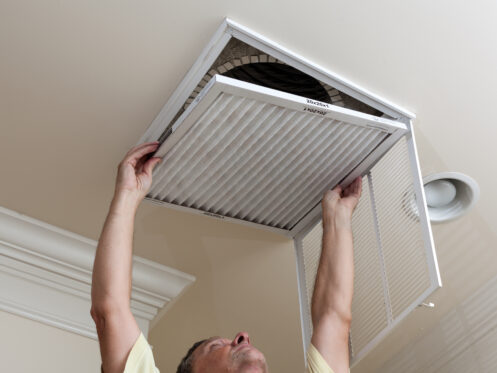A high-efficiency particulate air (HEPA) filter is a type of mechanical filter used primarily to protect indoor air quality (IAQ). Its primary job is to trap airborne particulate matter (PM) as air passes through it. HEPA is a type of pleated filter. That refers to filters that have a series of pleats in order to maximize surface area.
The HVAC team at JW Plumbing, Heating and Air explains the benefits of HEPA filters and how they can improve the indoor air quality of your Los Angeles home.
How Does a HEPA Filter Work?
Manufacturers once made HEPA filters from paper or cloth. Today, they tend to use glass fibers or PTFE, which is a synthetic fluoropolymer. You may know it as Teflon. The manufacturer arranges those fibers densely but randomly. As particles pass through, the filter traps them in one of three ways. Impact filtration refers to large particles caught in the net-like structure or adhering directly to a fiber. Interception refers to smaller particles that flow into the filter and get trapped in the web. HEPA filters trap very smooth particles through diffusion. This is when molecules collide with each other. They can’t leave with the flow of air and eventually become stuck in the web.
The History of HEPA Filtration
HEPA was a buzzword during the COVID-19 pandemic. That’s led many to believe it’s a relatively new invention. It isn’t. In fact, the National Defense Research Committee and U.S. Army Chemical Corps jointly developed it in the 1940s. They did so for the Manhattan Project. Those researchers needed a filter that could trap radioactive particles. After the war, the federal government declassified the technology, and HEPA was soon available for many different residential applications. What’s interesting is that HEPA hasn’t changed all that much in more than 80 years. Manufacturers have gotten more sophisticated in the processes and materials used, but HEPA filters today are still largely the same.
The Application of HEPA Filters in Residential Spaces
The IAQ industry commonly uses HEPA filtration for portable air purifiers and larger-scale room purifiers. Many whole-house air purifiers use HEPA as well but only standalone systems and those that operate on the HVAC return side. HEPA is too restrictive to use on the supply side of a central HVAC system. HEPA vacuum cleaners are common today as well. These vacuums do a better job of trapping dust and not recirculating it. You can also opt for HEPA filter bags that you can install in a non-HEPA vacuum.
The Benefits of HEPA Filtration in the Home
HEPA is ideal for fully sealed air purification systems. This means that the system forces all the air through the HEPA filter, and none escapes around the sides, for instance. HEPA is an effective choice for filtering both large PM and fine PM. It provides a significant amount of surface area even when the filter is relatively thin. Manufacturers can also easily make HEPA filters quite large. That includes length, height and width.
Large Particulate Matter
Large PM is a technical term that refers to particulates that are between 3.0 and 10.0 microns in size. Filtering large PM in a home is valuable because it includes dust. It also includes many other allergens, such as:
- Pollen
- Pet dander
- Mold spores
- Dust mite detritus
Fine Particulate Matter
Fine PM is a technical term that refers to particulates that are 2.5 microns or smaller. This is the PM that we associate with air pollution in industrial areas. Reducing fine PM in the home serves a couple of purposes. Ambient air pollution can actually become more concentrated indoors. If you live in an area with moderate or high air pollution, HEPA can help you combat it. Even in areas with low pollution, it can be worthwhile for people will asthma and allergies. The fine PM often serves as an irritant.
MERV
Minimum efficiency reporting value (MERV) is a scale used to assess filtration efficiency and airflow restriction. The higher the MERV rating, the better the filtration but also the lower the airflow. Most modern HVAC systems support a MERV between 8 and 13. HEPA filters are at least 16 MERV and often higher. This is why you cannot use them for your HVAC system.
HEPA: True HEPA and Medical-Grade HEPA
The Department of Energy (DOE) establishes minimum performance for HEPA. Unfortunately, there’s little regulation for retail products. Some brands will use terms like HEPA-type and HEPA-like. Such filters are unlikely to provide the HEPA performance you expect. You may also see terms like Standard HEPA and Approved HEPA. Those terms are just marketing and mean very little as well.
There are several labels that you should look for: True HEPA, H13 HEPA and H14 HEPA. A True HEPA filter meets DOE standards and filters 99.97% of all PM down to 0.3 microns. H13 and H14 are medical-grade HEPA filters. H13 filters 99.95% down to 0.2 microns. H14 filters 99.995% down to 0.2 microns.
How Do ACH and CADR Factor In?
A HEPA filter traps more than 99% of particles that pass through it. How effective a filter is in a real-world application depends on airflow. The air purifier motor provides a certain level of airflow measured in cubic feet per minute (CFM). The HEPA filter restricts airflow. To achieve the desired amount of filtration, the air purifier manufacturer must strike a balance between CFM and overall filter size.
Manufacturers often provide air changes per hour (ACH) or clean air delivery rate (CADR) to show the level of air filtration. ACH is most relevant to whole-house air purifiers. It’s relative to the total square footage that the manufacturer designed the system for. It indicates how often the system filters the total air. A 5 ACH air purifier filters all the air in a particular area five times an hour.
Manufacturers will generally use CADR for portable air purifiers instead. It’s a similar concept but optimized for smaller spaces. Allergists advise consumers to use the two-thirds rule of thumb. If you’re buying an air purifier for a 120-square-foot bedroom, for instance, target 80 CADR or higher.
What About Smoke, Gases and Chemicals?
HEPA filters do not filter smoke, gases, airborne chemicals, volatile organic compounds (VOCs) and so forth. This is why most air purifiers have an activated charcoal stage as well. The activated charcoal absorbs bad odors in addition to VOCs, smoke, fumes and so on.
What About Bacteria, Viruses and Microbes?
HEPA can filter these organisms to some degree but generally not to the level you would want. For that, you’ll want ultraviolet (UV) filtration. It’s a germicidal light that neutralizes pathogens and also dust mite eggs and fungal and mold spores. You can opt for UV either as an air purifier stage or by adding UV lamps to your ducts.
Your Local IAQ Experts in Los Angeles
JW Plumbing, Heating and Air is a family business that’s served Greater Los Angeles for over 30 years. Our company installs and repairs ducts and performs duct cleaning and duct sealing. Our IAQ team specializes in HVAC filters, dehumidifiers, humidifiers, air purifiers, air scrubbers and UV lamps. We have NATE-certified HVAC technicians that specialize in ducted and ductless cooling and heating systems.
That includes furnaces, heat pumps, air conditioners and mini-splits. Our technicians install and configure thermostats and zoned HVAC systems. We have a team of plumbers who perform plumbing repairs and pipe replacements. You can also count on us for water heaters, water treatment and sump pumps.
Contact us today to learn more about the AC maintenance services and other cooling solutions to schedule an appointment.


